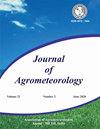北方邦西部平原区小麦、芥菜和鹰嘴豆作物的小气候研究
Q3 Agricultural and Biological Sciences
引用次数: 0
摘要
本研究在印度米鲁特(Meerut)莫迪普拉姆的印度农业系统研究所(ICAR-Indian Institute of Farming Systems Research)进行,旨在量化小麦、芥菜和鹰嘴豆作物下的小气候变化。从 7:30 到 17:30,每小时在距离地面不同高度(0.5 米、1.0 米和 2.0 米)记录小麦、芥菜和鹰嘴豆树冠下和树冠上的空气温度、相对湿度和二氧化碳浓度。二氧化碳探头如 GMP-343(扩散吸气式)用于记录二氧化碳浓度数据,HPM-75 探头用于采集空气温度和相对湿度的观测数据。结果显示,昼夜气温从上午到下午持续上升,13:30 时(下午)气温最高。此后,气温下降,17:30 时气温最低,与作物和离地面高度无关。不同高度的昼夜气温变化分析清楚地表明,与鹰嘴豆等矮小作物相比,小麦和芥菜等身材高大的作物气温较高(13:30 时),而鹰嘴豆等身材矮小的作物气温较低(15:30 时)。最高相对湿度出现在 7 时 30 分,最低相对湿度出现在 13 时 30 分或 15 时 30 分。研究发现,早晨 7:30 时二氧化碳浓度最高,15:30 时最低。在作物生长期的同一观测点,鹰嘴豆田的二氧化碳浓度最低(624 ppm),芥菜田的二氧化碳浓度最高(630 ppm)。本文章由计算机程序翻译,如有差异,请以英文原文为准。
Microclimatic study under wheat, mustard and chickpea crops in western plain zone of Uttar Pradesh
The present study to quantify the variations in microclimate under wheat, mustard and chickpea crops was conducted at ICAR-Indian Institute of Farming Systems Research, Modipuram, Meerut (U.P.), India. Air temperature, relative humidity, CO2 concentration below and above the canopies of wheat, mustard and chickpea were recorded at hourly interval from 07:30 to 17:30 hours at different heights (0.5 m, 1.0 m and 2.0 m) from the ground. CO2 probes like GMP-343, (Diffusion aspiration) was used to record data of CO2 concentration and HPM-75 probes was used to capture the observation of air temperature and relative humidity. Results revealed that diurnal air temperature was continuously increasing from morning to afternoon hrs and highest air temperature was recorded at 13:30 hrs (afternoon). Thereafter, air temperature decreased and reached to the lowest at 17:30 hrs irrespective of crops and height from the ground. Analysis of diurnal air temperature variations at different height clearly showed that tall statured crop such as wheat and mustard reached higher air temperature regime early (13.30 hrs) compared to short statured crop like chickpea at 15.30 hrs. Highest relative humidity was observed at 07.30 hrs and lowest relative humidity was recorded either at 13:30 hrs or at 15:30 hrs. As per study maximum CO2 concentration was found at 07:30 hrs morning and minimum at 15:30 hrs. The lowest concentration of CO2 (624 ppm) was recorded from the chickpea field and highest from the mustard field (630 ppm) at the same point of observation during vegetative phase of crops.
求助全文
通过发布文献求助,成功后即可免费获取论文全文。
去求助
来源期刊

Journal of Agrometeorology
农林科学-农艺学
CiteScore
1.40
自引率
0.00%
发文量
95
审稿时长
>12 weeks
期刊介绍:
The Journal of Agrometeorology (ISSN 0972-1665) , is a quarterly publication of Association of Agrometeorologists appearing in March, June, September and December. Since its beginning in 1999 till 2016, it was a half yearly publication appearing in June and December. In addition to regular issues, Association also brings out the special issues of the journal covering selected papers presented in seminar symposia organized by the Association.
 求助内容:
求助内容: 应助结果提醒方式:
应助结果提醒方式:


